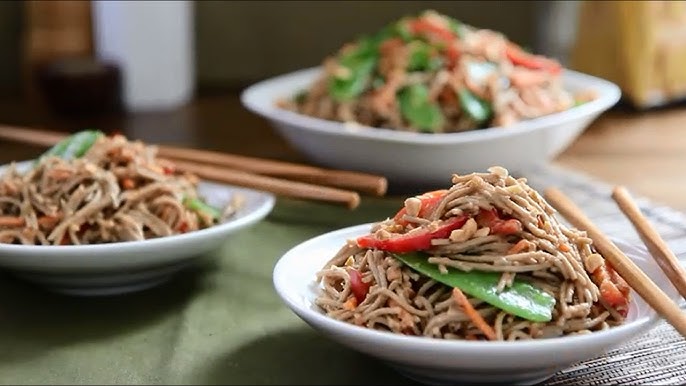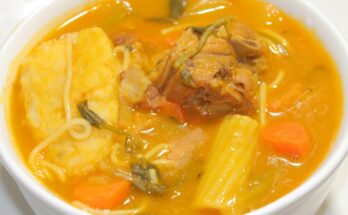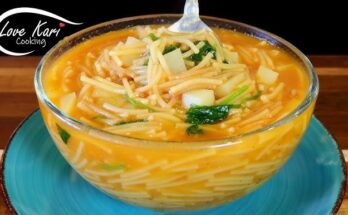Peanut Noodles Recipe: Peanut noodles are one of those magical dishes that combine simplicity, taste, and comfort all in one bite. They’re creamy, savory, just the right amount of tangy, and can be whipped up in under 30 minutes. If you’ve never tried them before, you’re in for a real treat. Think of spaghetti’s Asian cousin — slathered in a velvety peanut sauce that’s bursting with flavors like garlic, soy, lime, and a hint of sweetness. It’s the kind of dish that’s equally satisfying whether served hot, cold, or at room temperature.
These noodles originate from Asian cuisine, particularly inspired by Thai and Chinese dishes, but have now made their way into home kitchens across the globe. The peanut sauce, often similar to Thai satay sauce, gives it a rich depth of flavor. And the best part? You can make it completely your own. From veggies to proteins to spice levels, everything can be customized to your preference.
Whether you’re a student looking for an easy dinner, a busy parent needing a quick lunch, or a food lover on the hunt for bold flavors, peanut noodles deliver every time.
Ingredients You’ll Need
Here’s where the fun begins — the ingredients. The beauty of this dish lies in its flexibility. Most of these ingredients are pantry staples, and you can tweak them based on what you have on hand.
Core Ingredients:
- Noodles – You can use spaghetti, soba, rice noodles, or even ramen. The choice is yours.
- Peanut Butter – Creamy is best for texture, but crunchy can add an interesting twist.
- Soy Sauce – Adds that umami saltiness.
- Garlic – Freshly minced for punchy flavor.
- Ginger – Optional, but adds a lovely zing.
- Lime Juice or Rice Vinegar – Brings a needed acidity to balance the richness.
- Honey or Brown Sugar – For a hint of sweetness.
- Sesame Oil – Deep, nutty flavor that ties it all together.
- Chili Flakes or Sriracha – For that spicy kick (optional).
- Water or Coconut Milk – To thin out the sauce to your desired consistency.
Optional Add-ins and Toppings:
- Chopped Veggies – Carrots, bell peppers, cucumbers, or snap peas.
- Protein – Grilled chicken, tofu, shrimp, or tempeh.
- Garnishes – Chopped peanuts, sesame seeds, cilantro, scallions, lime wedges.
This dish welcomes creativity. Don’t be afraid to mix and match. Got leftovers in your fridge? Toss them in. This is your noodle canvas.
Kitchen Tools Required
The best part? You don’t need a fancy kitchen setup to make peanut noodles. Here’s all you really need:
Basic Kitchen Tools:
- Pot for boiling noodles
- Mixing bowl (for the sauce)
- Whisk or fork (to blend the sauce smooth)
- Colander (to drain the noodles)
- Tongs or spatula (for mixing everything together)
Optional Tools:
- Grater or Microplane (for ginger and garlic)
- Mandoline slicer (for thinly slicing veggies)
- Wok or large skillet (if you want to heat the final dish)
Most of these items are probably already in your kitchen. The key is to keep it simple. Less time with the tools means more time enjoying your noodles.
How to Make Peanut Noodles – Step-by-Step
Step 1: Cook the Noodles
Start by bringing a pot of water to a rolling boil. Add a pinch of salt and your noodles of choice. Cook according to the package instructions — usually around 8–10 minutes for spaghetti or 4–6 minutes for rice noodles.
Drain the noodles and rinse them under cold water if you want to serve the dish cold or prevent sticking. Toss them with a tiny bit of sesame oil to keep them from clumping together.
Pro Tip: Slightly undercook your noodles if you’re going to reheat them later. This helps them stay firm and not turn mushy.
Step 2: Prepare the Peanut Sauce
In a bowl, combine:
- 1/2 cup peanut butter
- 3 tablespoons soy sauce
- 1 tablespoon sesame oil
- 2 teaspoons honey or brown sugar
- Juice of 1 lime (or 1 tablespoon rice vinegar)
- 1 garlic clove, minced
- 1/2 teaspoon grated ginger (optional)
- 2 tablespoons warm water or coconut milk (adjust for consistency)
- Chili flakes or Sriracha to taste
Whisk until smooth and creamy. Adjust thickness with more liquid if needed.
Flavor Hack: Taste as you go! Want it tangier? Add more lime. Need it saltier? Another splash of soy sauce will do the trick.
Step 3: Combine and Toss
Place the drained noodles in a large bowl. Pour the peanut sauce over and toss well using tongs or chopsticks until every strand is coated in that golden, creamy goodness.
At this stage, you can mix in any chopped veggies or proteins. Think thinly sliced carrots, bell peppers, cucumbers, or some grilled chicken or tofu.
Sprinkle with chopped peanuts, green onions, sesame seeds, and a squeeze of lime before serving.
Pro Tip: If you’re serving this cold, let it sit in the fridge for about 30 minutes. The flavors meld beautifully over time.
Tips for Perfect Peanut Noodles
Making peanut noodles isn’t rocket science, but a few smart tips can elevate your dish from good to unforgettable. The difference between soggy, clumpy noodles and a dish that sings with flavor and texture lies in the small details.
1. Noodle Texture is Everything: Always aim for al dente — noodles that are firm to the bite. Overcooked noodles will soak up too much sauce and turn mushy, especially if you’re storing them for later. If you’re using rice noodles or soba, rinse them under cold water after cooking to stop the cooking process and prevent stickiness.
2. Get the Sauce Consistency Right: The sauce is the soul of this dish. Too thick and it won’t coat the noodles properly; too thin and it becomes watery. Use warm water or coconut milk to thin it out gradually. Whisk until smooth — lumps are a no-go. If using natural peanut butter (which can be gritty), blend the sauce for a silkier texture.
3. Balance the Flavors:
Peanut sauce should hit all the flavor notes — salty, sweet, tangy, and umami. Don’t be shy with a dash more lime juice or a drop of honey to adjust the flavor. Always taste and tweak before mixing with noodles.
4. Don’t Skip the Toppings: Crunchy toppings like chopped peanuts or sesame seeds provide texture contrast. Fresh herbs like cilantro or Thai basil add brightness, while scallions bring a mild oniony kick.
5. Mix While Warm: If you’re serving the dish warm, toss everything while the noodles are still hot. They absorb flavor better, and the sauce spreads more evenly.
Variations of Peanut Noodles
One of the best things about peanut noodles is how endlessly customizable they are. Whether you want to go spicy, vegan, gluten-free, or even use them in a salad — the options are wide open.
Spicy Thai-Style Peanut Noodles
If you’re a fan of heat, crank it up with Thai chili paste, Sriracha, or crushed red pepper flakes. Add some shredded carrots, bean sprouts, and a handful of chopped Thai basil. Garnish with crushed peanuts and a drizzle of chili oil for that signature Thai-style kick.
Cold Peanut Noodle Salad
Perfect for hot summer days or meal prep lunches, the cold version is refreshing and just as flavorful. Use soba or rice noodles, add crunchy veggies like cucumbers and bell peppers, and chill the noodles before mixing in the sauce. A touch of rice vinegar and sesame oil makes it extra zesty.
Vegan and Gluten-Free Options
Peanut noodles can easily be adapted for dietary needs:
- Vegan: Stick with maple syrup instead of honey, and ensure your noodles don’t contain egg.
- Gluten-Free: Use tamari or coconut aminos in place of soy sauce, and select certified gluten-free noodles like rice noodles or gluten-free soba.
Add Your Favorite Protein
Protein turns this from a snack into a full meal:
- Tofu: Pan-fried tofu cubes soak up the sauce beautifully.
- Chicken: Grilled or shredded, it adds heartiness.
- Shrimp: Quickly sautéed, they add a sweet-salty ocean flavor.
Nutritional Information
Peanut noodles are indulgent, but they also offer solid nutrition when balanced correctly. Here’s a general breakdown for one serving (based on a standard peanut noodle recipe with veggies and no added meat):
| Nutrient | Amount |
|---|---|
| Calories | 450–550 kcal |
| Protein | 12–18g |
| Carbohydrates | 40–55g |
| Fat | 22–30g |
| Fiber | 4–7g |
| Sugar | 5–8g |
Health Benefits:
- Peanut Butter provides healthy fats and protein.
- Veggies add fiber and vitamins.
- Whole Grain Noodles increase fiber and lower glycemic index.
To make your noodles healthier:
- Use less peanut butter and add more veggies.
- Opt for whole grain or rice noodles.
- Bake tofu instead of frying it.
If you’re on a calorie-conscious diet, keep portions moderate and pair it with a light side salad.
Serving Suggestions
Presentation can make a big difference, especially if you’re serving this dish to guests. Here’s how to take your peanut noodles to the next level when it’s time to serve.
1. Fresh Toppings Make It Pop: Top with freshly chopped cilantro, sliced scallions, crushed peanuts, and a lime wedge. These not only add color but also enhance the texture and flavor.
2. Plate Like a Pro: Twirl the noodles with a fork or tongs into a neat mound in the center of the plate. Surround it with veggies on the sides and drizzle extra sauce on top for that gourmet touch.
3. Pair with the Right Side: Peanut noodles go great with:
- A light Asian-style cucumber salad
- Steamed or sautéed bok choy
- Thai iced tea or sparkling water with lime
4. Serve Warm or Cold: Warm versions are cozier and comforting. Cold peanut noodles are perfect for summer or on-the-go meals. Either way, they taste fantastic.
Storing and Reheating
Peanut noodles make excellent leftovers — the flavors deepen overnight. But storing and reheating them the right way keeps them fresh and tasty.
Storing Tips:
- Store in an airtight container in the fridge for up to 4 days.
- Keep the sauce separate if you’re making it ahead — this prevents sogginess.
- If using fresh herbs or toppings, add them just before serving.
Reheating Tips:
- Add a splash of water, broth, or coconut milk before reheating to loosen up the sauce.
- Warm in the microwave in 30-second bursts, stirring in between.
- If heating on the stove, use low heat and stir gently to prevent sticking.
Cold peanut noodles are also great as-is — just give them a toss and they’re ready to go.
Common Mistakes to Avoid
Even though peanut noodles are straightforward to make, a few common slip-ups can sabotage the final dish. Avoid these pitfalls and you’ll be on your way to peanut noodle perfection every time.
1. Overcooking the Noodles: This is the most frequent mistake. Overcooked noodles absorb too much sauce and turn into a sticky mess. Always cook them al dente. If you’re using rice noodles, soak or boil just until soft — they can go from perfect to soggy fast.
2. Using Cold Peanut Butter Straight from the Fridge: Peanut butter that’s too cold doesn’t blend easily and can lead to a lumpy sauce. Warm it slightly or let it sit at room temperature before mixing. Better yet, stir in warm water or broth to help it melt into a smooth, creamy texture.
3. Skipping the Acid Component: Lime juice or rice vinegar isn’t just an optional zing — it balances the richness of the peanut butter and soy sauce. Without it, the sauce can feel too heavy.
4. Not Tasting and Adjusting: The sauce is the heart of this dish. Always taste and tweak as needed. Some peanut butters are saltier or sweeter than others, so don’t be afraid to add a splash more soy or a pinch more sugar to get it just right.
5. Adding All Veggies at Once: Not all veggies cook the same. Add crunchy ones like carrots and bell peppers early; delicate greens like spinach or herbs should go in at the end to maintain their texture and flavor.
Why You’ll Love This Recipe
Peanut noodles are the kind of dish that wins hearts and stomachs every single time. Here’s why they deserve a permanent spot in your meal rotation.
1. Bold, Addictive Flavors: Creamy peanut butter mixed with salty soy, tangy lime, sweet honey, and a hint of spice is simply irresistible. Every bite is a little party for your taste buds.
2. Incredibly Versatile: You can serve them hot or cold, as a main or side, vegetarian or with protein. It’s a recipe that adapts to your cravings, schedule, and pantry.
3. Quick and Easy to Make: Even if you’ve never cooked before, you can make peanut noodles in under 30 minutes — and that includes chopping veggies and cooking noodles. It’s perfect for busy weeknights or lazy weekends.
4. Meal Prep Hero: Make a big batch, store in the fridge, and you’ve got lunch or dinner sorted for days. The flavors actually get better with time!
5. Crowd-Pleaser: Whether you’re feeding kids, picky eaters, or spice lovers, this dish hits the mark. You can adjust the heat level and toppings to suit everyone.
If you’re after a no-fuss, flavor-packed, totally customizable meal, this peanut noodle recipe is it.
Pairing Ideas
Pairing peanut noodles with the right sides and beverages can turn a simple meal into a well-rounded feast. Here are some tasty and creative options to try:
Side Dishes:
- Asian Cucumber Salad: Thinly sliced cucumbers with rice vinegar, sesame oil, a pinch of sugar, and chili flakes — light, crisp, and refreshing.
- Steamed Dumplings: A soft, savory contrast to the creamy noodles. Pork, veggie, or shrimp dumplings work beautifully.
- Spring Rolls: Fresh or fried, filled with crunchy veggies or shrimp, they complement the richness of peanut noodles.
- Miso Soup: A light, umami-rich soup that balances out the hearty noodles.
Beverages:
- Thai Iced Tea or Coffee: Creamy, sweet, and perfectly indulgent alongside the spicy-savory flavors.
- Sparkling Water with Lime: Cleanses the palate and keeps things light.
- Chilled White Wine or Sake: Great for dinner parties or date night.
Whether you’re planning a casual dinner or a fun gathering with friends, these pairings enhance the overall experience and showcase the noodles as a central star.
Reader Reviews and Testimonials
Curious about what others are saying? Here are a few testimonials from folks who’ve tried and loved this peanut noodles recipe:
“This has become our family’s favorite weeknight meal! My kids ask for it at least twice a week. So easy and delicious.”
— Amanda J.
“I added grilled tofu and served it cold for lunch the next day. Even better than takeout!”
— Marcus P.
“Was skeptical about using peanut butter in noodles but WOW. The flavor combo is next level. Will definitely make again.”
— Sophie R.
“I’m not a great cook, but this recipe made me feel like a pro. Topped mine with extra lime and cilantro. Perfection.”
— Tyler K.
Reading reviews like these shows just how universally loved this dish is. Whether you’re a beginner or a seasoned chef, it’s a hit in every kitchen.
FAQs about Peanut Noodles Recipe
1. Can I make peanut noodles ahead of time?
Yes! Peanut noodles store well in the fridge for up to 4 days. Just keep the sauce and toppings separate if possible for best texture.
2. Are these noodles spicy?
Only if you want them to be. The base recipe is mild. Add chili flakes, hot sauce, or sriracha to turn up the heat.
3. Can I use crunchy peanut butter?
Absolutely. It adds a bit of texture, which some people love. Just know it won’t be as smooth unless blended well.
4. What type of noodles work best?
Spaghetti, rice noodles, soba, or even ramen — the choice is yours. Just make sure to cook them al dente.
5. How long do peanut noodles last in the fridge?
Up to 4 days when stored in an airtight container. Add a splash of water or coconut milk when reheating to refresh the sauce.
Conclusion
There’s something incredibly satisfying about a bowl of peanut noodles. It’s comfort food with flair — creamy, savory, sweet, tangy, and just a touch spicy. Whether you’re eating it straight from the fridge after a long day or plating it up for guests with a flourish, it delivers every time.
The recipe is forgiving, flexible, and can be tailored to any diet or taste preference. Plus, with how easy it is to make and store, it’s no wonder peanut noodles have earned a permanent place in kitchens around the world.
So grab that jar of peanut butter, boil those noodles, and let your taste buds dance.



